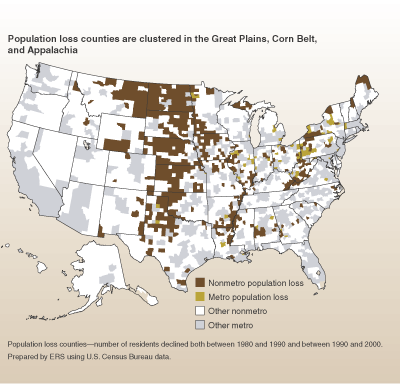Population Loss Counties Lack Natural Amenities and Metro Proximity
- by John Cromartie
- 4/1/2005
Population growth is often a key indicator of economic and social well-being. Population loss, on the other hand, often signals weak economic conditions in the community. Hundreds of towns throughout a wide swath of America’s Heartland face an entrenched form of population loss, often covering several decades. The root cause of this pattern is technological change, which has led to increased agricultural production with less labor. Such changes have resulted in long-term declines in farming-related jobs and increases in off-farm jobs. As rural businesses, schools, and hospitals have closed in response to waves of outmigration, compounded by rising costs for providing critical services, rural communities face cycles of outmigration that are difficult to break. To highlight the fiscal and policy choices stemming from such conditions, ERS added Population Loss Counties to its recently updated county typology. Population loss counties are those that lost population in both the 1980s and 1990s.
Of the 2,052 nonmetro counties in the U.S., more than 25 percent are classified as population loss counties, with an average population size half that of other nonmetro counties. In 2003, only 15 percent of nonmetro residents (7.6 million of 49.8 million people) lived in these counties. They are most heavily concentrated in the Great Plains and extend eastward into the Corn Belt. North Dakota experienced the most widespread pattern of outmigration of any State, with declines in all but three of its nonmetro counties. Other clusters of population loss counties are found in the lower Mississippi Valley and central Appalachia. Only 6 percent of metro counties lost population in both of these decades. (Western Pennsylvania includes the only significant cluster of metro counties losing population.)
Renewed population growth in many rural and small town settings is thwarted by remoteness from urban centers and lack of natural amenities, such as temperate climates and landscapes with open vistas. Population loss counties are far more likely than other nonmetro counties to be classified as farming dependent and are far less likely to have developed an alternative economic base. The same geographic characteristics that are ideal for agriculture—relatively flat topography, long, hot summers, and isolation from urban encroachment—are not conducive to economic development from recreation, tourism, or retirement. Less than 4 percent of nonmetro population loss counties are also classified as recreation counties in ERS’s typology (compared with about 18 percent of all other nonmetro counties), and less than 1 percent are typed as retirement destinations. In addition, population loss counties are half as likely to be adjacent to metro counties than other nonmetro counties.
Lack of natural amenities, rather than the presence of agriculture per se, creates barriers to renewed population growth in many rural and small town settings. Indeed, population loss is noticeably absent in the intermountain West and coastal settings, where recreation and retirement economies prevail. Solutions to stem population loss are varied and yield mixed results in areas with few employment prospects. For example, one strategy—to locate less desirable facilities, such as prisons and waste disposal plants, in such areas—has had some success. Another approach to attract residents to rural areas is to use tax breaks and credit incentives (as in the proposed New Homestead Act) in counties experiencing long-term outmigration.
This article is drawn from:
- County Typology Codes. (n.d.). U.S. Department of Agriculture, Economic Research Service.


